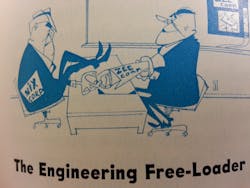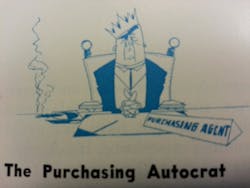Free engineering is, of course, design help from engineered equipment manufacturers who are bidding for your business. It’s valuable; in many instances, indispensable. You just wouldn’t buy complex conveyor systems, overhead cranes, or any equipment requiring special design without depending on the supplier to do a substantial part of the engineering.
But free engineering is never really free. Sometimes it is extremely costly.
Case in point: Company A, a heavy machine manufacturer, was planning an assembly line for a new model. The engineers, after some preliminary design, decided that they needed a high capacity, heavy-duty, straight-line conveyor. Nothing fancy, but not standard with any manufacturer.
In order to prepare bids, potential suppliers would have to prepare complete drawings which would include necessary modifications.
Company A set sketches and brief specifications to 18 conveyor manufacturers for quotations. All responded. Eight of the 18 bidders were disqualified because their type of equipment was unacceptable (for design restrictions which had not been clearly stated in the original specifications). Company A then instructed each of the remaining 10 bidders, separately, to: “recheck your design, your price is not in line.” This meant that all 10 manufacturers had to send sales engineers top discuss the bids with Company A’s engineers. Many of them had to come from out of town.
Three months later, after three bidding cycles, the conveyor was bought for about $40,000.
On the surface, Company A appeared to have been cautious and smart, By taking plenty of time to investigate many types of conveyors and by playing one manufacturer after the other, until the price could go lower, they had saved money while getting the best possible system.
But had they?
Here’s what they really did:
They wasted more than $9,000 worth if engineering effort just finding out who could bid on the system.
Each of the 18 conveyor manufacturers spent about $500 in pre-bid design. Altogether this amounted to 22.5% of the total cost of the job. True, Company A did not pay for it on this particular job, but subsequent customers of the bidding companies—possibly you—did.
They added to sales expense while paring prices.
When bid rechecking started, the ten bidders who had passed the first hurdle had to absorb several hundred dollars in sales expense.
They wasted their own time.
Company A’s engineers and purchasing agents had to sit in on more than 30 time-consuming conferences with sales engineers.
They caused high construction costs.
By the time a conveyor supplier had been selected, they were dangerously close to the deadline for starting production of the new model. As a result, installers had to work overtime (at Company A’s expense) and the savings they thought they made from bid shaving were wiped out.
It was a costly experience. It resulted from unwise purchasing policies and wasteful use of free engineering. But Company A is not alone. Large and small firms throughout industry do the same sort of thing. Combined, they are responsible for keeping material handling equipment costs at artificially high levels.
Abuse of free engineering services takes several different forms. Which of the following profiles fit you?
The Scatter-Shot Requisitioner
The most common offender. He asks too many potential suppliers to bid. Company A is a prime example.
The Engineering Free-Loader
There are two species:
a. The Contract-it-Yourselfer hurts only himself. He will ask potential suppliers to provide detailed drawings. Then he will buy his components and have them installed by local crews who might not have material handling experience. It’s cheaper this way, at the start. But remember, you have to pay for every mistake , every revision. In the long run, it’s cheaper and certainly safer to pay a reliable equipment manufacturer to bear the responsibility for seeing that the system you want is installed on time and operating the way you want it.
b. The Blue-Print Peddler. He not only adds to costs, but is guilty of unethical practices. He has an ace-in-the-hole, the No Engineering Overhead-er, whom he doesn’t call on until after one more of the reliable manufacturers have designed a good system.
The No-Engineering Overhead-er does no design work, just sells and installs equipmemnt to your specifications. As when you contract for yourself, though, blueprint peddling looks good only at first. Once your system has been installed, you’re on your own.
There’s another pitfall. It doesn’t take suppliers long to find out you are picking their brains.
Example: Company B, a manufacturer of drain tile, asked a distributor of handling equipment, the Zee Corp., to help it design a new storage and handling system. Zee’s engineers spent two weeks designing a rack-container system. Complete drawings and prices were submitted.
A few days later, the owner of a small metal fabricating job shop called a Zee Corp. executive.
“We have been asked to bid on a job that should be up your alley. Your products were just made for this type of application,” the job shop owner said.
Further discussion revealed that he was talking about the system designed by Zee Corp.. Even the drawings were the same, although they now carried Company B’s title block.
The Zee Corp. executive called Company B and told them that portions of the system were patented and any other supplier would have to be licensed to provide the equipment. The extent of Company B’s blueprint peddling became obvious during the next few weeks when 18 would-be bidders asked Zee Corp. for clearance.
You can expect a big change in vendor attitudes once they learn about your peddling activities. You’ll get only sketchy information with bids if they even bother to bid. Or, submitted drawings might contain intentional errors which, if built into the system, could mean trouble from then on. Harsh retribution for a little innocent brain picking? Yes, but it is the sales engineer’s only means of protection.
The Bargain Hunter
This abuser of free engineeringworks in two ways. He will buy price over all other considerations, or he will put bidding on an auction-block basis.
a. Price Buying—Closed bid contracts for multi-thousand dollar systems have been awarded for a price differential as low as one dollar, regardless of design considerations.
When price becomes this important , it is at the expense of more important factors, such as operating efficiency , maintenance requirements and length of life.
Example: Company C decided it needed a new handling system. Its engioneers submitted rough specifications to six possible suppliers . Five followed the specifications. The other companies cut corners. It took exception to several requirements listed in the specification and as a result was able to underbid the others. It got the contract.
Company C saved money then, but has been paying the difference over and over in attempts to get the equipment to perform as it should.
b. Auction-Block Buying—Company D needed three overhead cranes . Seven manufacturers were asked to submit drawings and to bid on the installation. After all had responded, each was told separately that his bid was too high. Each was given a chance to re-bid. When the second bids were in, they were called in again and told the same story. It happened a third time.
Finally the contract was awarded. But at what cost?
Every time a supplier prepared a new bid it cost him about 30 hours of engineering time. At a conservative rate of $10 an hour, this amounted to about $300 per manufacturer. A total of $2100.
Every supplier salesman call required the attention of a Company D engineer.
During the re-bidding, production was held up.
The Purchasing Autocrat
The purchasing agent should be, and usually is, an important person in a company’s operations. Sometimes, by management edict, he is an untouchable, charged with making profits on the firm’s purchases. A valuable contribution, if carried out intelligently. Yet, when not properly guided, the purchasing agent can save a dollar and waste hundreds.
Example: Company E operates a processing plant. It wanted to install a system which would save 4 cents a pound of product. It processes about 300,000 pounds per month. Thus, the day the new system went into operation they would save $12,000 per month.
Company E’s engineers called on a consulting engineer to help design the new system. He was paid a fair fee for his services.
Wy Corp., an equipment manfacturer, was asked to bid on the systemthat the consultant had drawn up.
In preparing its bid, Wy Corp. found several areas where it could improve on the consultant’s design. They redrew the system, incorporating the changes and submitting them to Company E and the consultant. Both accepted the changes in every detail and agreed that the price was satisfactory.
The day the purchase order was to be issued, another vendor came in and quoted an off-the-cuff price 30% below Wy Corp.’s. The purchasing agent saw a chance to save a lot of money and, acting within his rights as established by management, awarded the contract to the second manufacturer. The engineers weren’t even consulted.
The equipment was installed in accordance with Wy Corp.’s specifications. Then the troubles started. The system did not work right until eight months after the date Wy Corp. had guaranteed smooth, full speed production.
Eight months of lost production, at potential savings of $12,000per month, adds up to $96,000 worth of savings lost forever because the purchasing agent could not see beyond the immediate profit he was making for his company.
Sometimes, the purchasing agent’s ivory tower becomes a fortress.
Example: Vee Corp., a sales organization for engineered equipment, received an inquiry from Company F. The information it contained was hard to understand, so the Vee Corp. salesman called Company F’s purchasing agent. He was of no help.
“Tell me the name of the engineer who wants the equipment. I’d like to talk to him about this,” the salesman asked.
“Sorry, I can’t do that,” was the answer. “You’ll have to deal exclusively through me.”
With the salesman on the outside line, he called the engineer on the inner office phone and carried on a double conversation with the two phones, in best movieland businessman style. He relayed questions and answers back and forth, probably distorting both enroute. Because of the complexity of the equipment involved, the sales engineer was not able to get enough accurate information to justify his taking time to design a system and submit a proposal. He dumped the inquiry in the waste basket.
The Vee Corp.’s sales engineer lost a sale, but more importantly, Company F lost the benefit of his design help.
The Panic Buyer
The equipment you buy will have to operate a long time. Allow your suppliers enough time to design it properly. Otherwise you might have a unit which won’t operate at all.
Example: Company G needed a special overhead handling system. Because of the type of operation, standard equipment could not be used. A modified design was necessary. Here’s the time schedule which was followed in purchasing this expensive equipment:
Monday—Two manufacturers were notifiedthat Company Gneeded the equipment. They were told that their proposals, complete with drawings, had to be submitted no later than Wednesday of that week.
Tuesday—The two manufacturers were advised, “If you do not have your bid in by noon tomorrow, you will not even be considered for the job. We’ve got to move fast on this.”
One company chose to develop the best possible plan, despite the ridiculously short time allowed. They put their best engineer on the job, around the clock, Monday and Tuesday, right up to the Wednesday deadline. He designed a good systemthat took into consideration the special problems involved.
The other company gave Company G what it probably deserved, a short-cut system not tailored to the specific needs. Its price was lower by far.
Wednesday—The contract was awarded, strictly on price.
One year later—the equipment sits idle. It never has worked properly and is a silent, costly monument to panic buying and mis-use of free engineering.
Solutions
- Keep the number of bidders low—one, if possible. Never more than three.
- If you want engineering help from more than three firms, pay for it.
- Tailor the firms you call into the job you want done. Learn all you can about them…past performance, experience, etc.
- Don’t procrastinate, hoping to get a 1962 model in 1960. Get busy now and satisfy the need. Otherwise you might become a panic buyer.
- Don’t let the purchasing agent become a purchasing autocrat, especially when he is dealing with highly technical, specially engineered equipment. Permit material handling engineers to play a big part in selecting this type of equipment.
- Don’t peddle blueprints.
- Let the manufacturer who designed the system build it.
Honestly now, how much do YOU add to the cost of material handling equipment?






